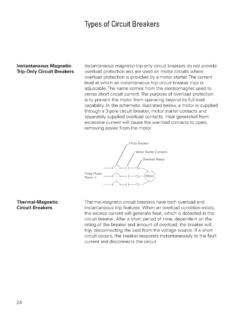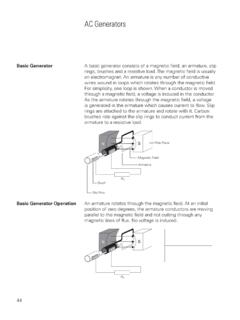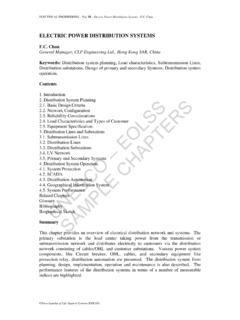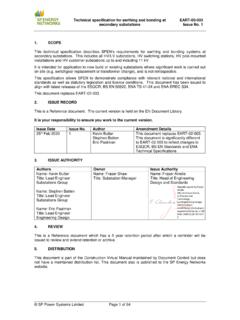Transcription of Types Of Load Centers - EandM
1 44 Types Of Load CentersMain breaker There are two Types of load Centers , main breaker and main lug only. Main breaker load Centers are suitable for use in service entrance applications. The incoming supply cables of a main breaker type load center are connected to the main breaker which in turn feeds power to the load center and its branch circuits. The main breaker disconnects power from the load center and provides overcurrent protection. 45 Main Lug Only The following illustration shows the interior of a main lug only load center. A main lug type load center does not have a main circuit breaker . The incoming supply cables are connected directly to the main lugs and bus bars. Primary overload protection for the load center is not provided as an integral part of the load center.
2 Main lug units are primarily used as a distribution panel where there is a main breaker upstream in the system. There are situations where a back fed circuit breaker and a retainer clip (required by NEC ) are used to convert a main lug load center to a main breaker load center. Main lug load Centers are sometimes referred to as add-on, secondary or downstream panels. These panels are added when all circuit slots in the main breaker load center are full or when a remote panel is desired. For example, a main breaker load center might supply power to a main lug load center located in an area of the home used as a workshop. Main lug load Centers are also fed from metering equipment when used in apartment and National Electrical Code are registered trademarks of the National Fire Protection Lugs There are two ways to sub feed power to a secondary load center.
3 One way is to use a branch circuit breaker or a plug-on lug kit in the existing load center. Another way is to use a load center with feed-thru lugs. In the following illustration utility power is supplied to a main breaker load center. Power is taken from the feed-thru lugs and supplied to another load center downstream. 47 Load Center RatingsWhen selecting load Centers and overcurrent protection devices, it is extremely important to know both the maximum continuous amperes and available fault current. NEC article states:Equipment intended to interrupt current at fault levels shall have an interrupting rating sufficient for the nominal circuit voltage and the current that is available at the line terminals of the intended to interrupt current at other than fault levels shall have an interrupting rating at nominal circuit voltage sufficient for the current that must be Rating There are two ways to meet this requirement.
4 The full rating method is to select circuit protection devices with individual ratings equal to or greater than the available fault current. This means that, in the case of a building with 22,000 amperes of fault current available at the service entrance, every circuit protection device must have an interrupting rating of at least 22,000 amperes. In the following example, the main circuit breaker and each branch breaker is rated 22,000 and National Electrical Code are registered trademarks of the National Fire Protection Association. Reprinted with permission from NFPA 70-2002, the National Electrical Code , Copyright 2001, National Fire Protection Association, Quincy, MA Rated The series rated method is that the main upstream circuit protection device must have an interrupting rating equal to or greater than the available fault current of the system, but subsequent downstream circuit protection devices connected in series can be rated at lower values.
5 For example, a building with 22,000 amperes of available fault current might have the breaker at the service entrance rated at 22,000 amperes and additional downstream branch breakers rated at 10,000 amperes. In single family homes the available fault current normally does not exceed 10,000 amperes. In this situation a load center with a main and branch circuit breakers with an interrupting rating of 10,000 amperes will satisfy the requirement. In some instances the available fault current may exceed 10,000 amperes, but rarely 22,000 amperes. In these instances a load center with a main circuit breaker with an interrupting rating of 22,000 amperes would be required. Using the full rating method the branch breakers would also have to be 22,000 amperes.
6 Using the series rated method the branch breakers could be 10,000 amperes. 49In larger installations, such as apartments, condominiums and commercial facilities, the available fault current will normally be greater than 10,000 amperes. In these situations it is not uncommon to see three breaker series combinations. The main power of an apartment complex, for example, might have 65,000 amperes available fault current. The main disconnect must be capable of interrupting this fault current. The feeder disconnects, however, may only have to be rated for 22,000 amperes of fault current, and individual apartments rated for 10,000 amperes of fault breaker combinations must be tested in series in order to be UL recognized. The NEC requires the series ratings to be marked on the load center ( ).
7 Selected series rated breakers are listed in the Speedfax catalog. Your Siemens sales engineer can provide more information on Siemens series-rated circuit breakers. NEC and National Electrical Code are registered trademarks of the National Fire Protection Overcurrent ProtectionThe National Electrical Code requires load Centers to be individually protected against overcurrent. Main overcurrent protection may be an integral part of a load center or located remote from the load center. NEC Article (A) states that each lighting and appliance branch- circuit panelboard shall be individually protected on the supply side by not more than two main circuit breakers or two sets of fuses having a combined rating not greater than that of the panelboard.
8 Individual Protection The following illustration shows two possible ways individual load center overcurrent can be accomplished. If a main circuit breaker is located as an integral part of the load center, it is a main breaker load center. If a main circuit breaker or main fusible is located remotely, then a main lug load center could be used. In this example the main breaker and load center are both rated for 200 amps. 51 Exception to NEC There is an exception to NEC Article (A). Exception No. 1: Individual protection for a lighting and appliance panelboard shall not be required if the panelboard feeder has overcurrent protection not greater than the rating of the panelboard. The following illustration shows two load Centers protected by a single 200 amp circuit breaker .
9 Note that the circuit breaker provides overcurrent protection not greater than the rating of the load and National Electrical Code are registered trademarks of the National Fire Protection Association. Reprinted with permission from NFPA 70-2002, the National Electrical Code , Copyright 2001, National Fire Protection Association, Quincy, MA Entrance/Equipment Load CentersLoad Centers are frequently used as service equipment for a building. This is the equipment located near where the power supply enters the building. The incoming power supply is connected to this equipment which provides a means to control and cut off the supply. The National Electrical Code discusses service entrance equipment in Article 230. Load Centers used as service equipment must be listed and labeled as such.
10 All Siemens EQ main breaker load Centers are factory labeled as suitable for use as service equipment. NEC and National Electrical Code are registered trademarks of the National Fire Protection Number of Service-entrance conductors must have a readily accessibleDisconnects for Service means of being disconnected from the power supply. NEC Entrance Equipment Article (A) specifies that for each set of service entrance conductors no more than six switches or circuit breakers shall be used to disconnect and isolate the service from all other equipment. There are two ways load Centers can be configured to meet this requirement. In one example, a main breaker load center is used. A single main circuit breaker will disconnect power to all equipment being supplied by the service.









